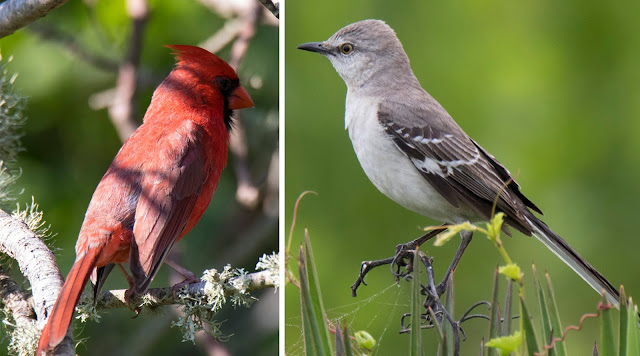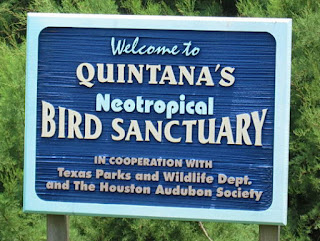 |
| Female Blue Grosbeak, left, and male Indigo Bunting, right |
Now, I was on my way to an interesting little gem, the Quintana
Neotropical Bird Sanctuary in Quintana, Texas. I had seen so many pictures on
Facebook that I knew it would deliver the goods.
But, I had to get there first. It’s a six-hour drive through
increasingly flat cattle-country. I saw a few patches of Bluebonnets on the way
but, although I was hoping that I’d see some nice fields of blue on the way, it was too late in
the season. That’s the story of my experiences with Bluebonnets – either too
early or too late.
Despite winding along some pretty country roads, I didn’t
really encounter anything interesting except lots and lots of Black Vultures,
many of them sitting (somewhat ominously) in the rain on low fences.
 |
| Very cool birds |
I kept hoping that I would see some in a graveyard. It didn’t happen. But, what a cool picture that would be.
But, let’s talk about the Quintana Neotropical Bird Sanctuary. It has an interesting story. Quintana is a little beach community completely engulfed by major – I mean MAJOR – chemical companies on the Texas Gulf Coast. There are 11 – yes, 11 – Dow Chemical facilities in the area. Fortunately, I had been warned not to expect pretty surroundings. And, almost all of my bird pictures ended up being close-ups (except the Black-bellied Whistling Ducks).
I had
intended to stop and take photos of the huge industrial complex, but I never
did. This is one of my blogging flaws. I tend to photograph only what is
beautiful, thus missing parts of the true story. Plus, when I am taking pictures of birds, I often ignore my camera with a wide-angle lens and just carry the long lens. A close-up doesn't have the impact of the full view.But, let’s talk about the Quintana Neotropical Bird Sanctuary. It has an interesting story. Quintana is a little beach community completely engulfed by major – I mean MAJOR – chemical companies on the Texas Gulf Coast. There are 11 – yes, 11 – Dow Chemical facilities in the area. Fortunately, I had been warned not to expect pretty surroundings. And, almost all of my bird pictures ended up being close-ups (except the Black-bellied Whistling Ducks).
 |
| Photo: Center for Health, Environment & Justice |
Anyway, back to Quintana.
On an island south of Freeport and Lake Jackson between the mouths of the Old Brazos and the New Brazos Rivers, the two-square-mile town.
On an island south of Freeport and Lake Jackson between the mouths of the Old Brazos and the New Brazos Rivers, the two-square-mile town.
It’s a sleepy little beach community with an official population of 38.
I suspect
that most of the houses are for weekend and vacation use and it has a good-sized campground, so there is generally a larger concentration of people.
Quintana's history dates back to 1528! Survivors of the Spanish Narváez Expedition, which was looking for gold (as most Spaniards were at the time), were adrift and dying of thirst when they found a current of potable muddy water flowing from the Gulf. They followed this "fresh water from the sea" to the mouth of the Brazos, which led them to the site of Quintana. Interestingly, that expedition started with 600 men in what is now the Dominican Republic and ended eight years later with four men in Mexico City -- and, still, no gold.
Texas forefather Stephen F. Austin was commissioned to lay the town out in 1833. He named it after General Adreas Quintana, deputy minister of Mexican Foreign and Internal Affairs, who was sympathetic to Austin's efforts to colonize the area. The new town prospered with a dry goods warehouse, meat market, school, hotel, grocery store and post office.
Quintana happens to be an excellent birding spot because it is the first place many birds can make landfall after their 600-mile migration over the Gulf of Mexico as they head to their breeding grounds in the north.
Quintana's history dates back to 1528! Survivors of the Spanish Narváez Expedition, which was looking for gold (as most Spaniards were at the time), were adrift and dying of thirst when they found a current of potable muddy water flowing from the Gulf. They followed this "fresh water from the sea" to the mouth of the Brazos, which led them to the site of Quintana. Interestingly, that expedition started with 600 men in what is now the Dominican Republic and ended eight years later with four men in Mexico City -- and, still, no gold.
Quintana happens to be an excellent birding spot because it is the first place many birds can make landfall after their 600-mile migration over the Gulf of Mexico as they head to their breeding grounds in the north.
 |
| Good for birding |
 |
Photo: U.S. Fish and Wildlife Service
|
Some of the birds are on an expected migratory path – in other words,
birds you could EXPECT to see in south Texas during the migration,
Some
are not. Those are birds that got blown off course and have stopped to rest
before traveling on to where they are supposed to be.
The term Neotropical refers to Central and South America,
including the tropical southern part of Mexico and the Caribbean. Many of the
birds passing through the sanctuary winter in those areas and breed in North
America.
I heard – but did not witness – that there are times when
birds are so exhausted that they literally drop from the sky in Quintana. I
even heard that this year, because of heavy headwinds, some little birds died
on the beach after reaching their destination. The trip was just too difficult.
More than 325 species have been recorded there and (and I
got this right) April is the best month. I didn’t hit near that number – I
recorded 36 different species in the approximately 12 hours I spent there over
two days and 13 were lifers for me.
 |
| Lifers: Common Blackpoll Warbler, Hooded Warbler, Black-and-white Warbler |
The town purchased the small tract across from the Town Hall in 1994 with the help of a grant from Partners in Flight. They cleared the brushy land and built a nature trail, water features, benches and an observation tower, with the help of funds and volunteers from the local chemical companies
 |
| Flowers |
In September 2008, Hurricane Ike damaged the sanctuary and
a lot of the tree cover was lost. Hurricane Harvey did more damage in 2017, but
it was pretty well cleaned up.
The Sanctuary has plenty of places to watch birds, but the only actual blind looks into a water feature that is so shaded that it really isn’t worth trying to photograph birds there. You have much better luck catching them along the paths.
The Sanctuary has plenty of places to watch birds, but the only actual blind looks into a water feature that is so shaded that it really isn’t worth trying to photograph birds there. You have much better luck catching them along the paths.
And, speaking of paths … Within minutes of my initial
arrival, an adorable little Hooded Warbler (a lifer for me) hopped toward me on
the trail. It got so close that I had to back up to keep it in focus. This
little cutie was definitely my favorite bird at the sanctuary. I saw several.
None were shy.
Many of the other birds were more challenging, including a
few that I saw but never got a shot of. But, it was impressive. I am sure if
you came back repeatedly over the course of a few days or weeks, you would see
a stunning variety. Plus, there are beautiful flowers as well.
So, here’s a rundown of the birds I did see (and photograph -- the American Redstart got away).
 |
| Female Rose-breasted Grosbeak, left, and Love Bugs, right |
Great Blue Herons along the highway approaching Quintana …
 |
| Take off |
An Eastern Wood-Pewee …
 |
| Such a cutie |
 |
| Many expressions |
... and one who wanted us to see his rufous vent ...
 |
| The colors! |
Orchard Orioles (here is a juvenile, an adult male and an adult female) ...
 |
| Such variety |
A Great-crested Flycatcher …
 |
| Love the rufous on the wings |
 |
| Show-off |
A Swainson’s Thrush …
 |
| Taken in a very dark cove |
 |
| A brief rest |
A Red-eyed Vireo …
 |
| Look at the eye |
 |
| Quick snack |
A Scarlet Tanager (I also saw some Summer Tanagers, but none
were as pretty as the ones at South Llano and I didn’t get pictures) …
 |
| Color! |
Indigo Buntings (male and female) ...
 |
| More color! |
Painted Buntings (also male and female) …
 |
| And even more! |
Warblers galore, including the Black-and-white Warbler …
 |
| And, a bird in black-and-white |
… a Common Blackpoll Warbler (this bird was at the very western edge of its migration path and created quite a commotion for birdwatchers) …
 |
| More black-and-white |
... a Blue-winged Warbler …
 |
| A little more color, again |
 |
| I chased this one for awhile |
... and Tennessee Warblers …
 |
| A cute little bird |
 |
| I am tired of people calling them "morning" doves; the name is for their mournful call |
A Northern Mockingbird and Northern Cardinals …
 |
| Why are they “Northern?” I always see them in the south! |
 |
| The male is the blue one |
And, a female Rose-breasted Grosbeak …
 |
| I tried to find the much prettier male, but he was nowhere to be found) |
Black-bellied Whistling Ducks that like to sit in trees and
on wires in a very un-duck-like fashion ...
 |
| Ducks on a wire |
Bronzed Cowbirds …
 |
| A graceful Blackbird |
Great-tailed Grackles …
 |
| A very common bird in Texas and often quite showy |
… And, those friendly little Hooded Warblers, female …
 |
| Not as dramatic as her hubby |
... and male ...
 |
| My favorite! |
A big treat was a Chuck-will’s-widow tucked way back in the
bushes trying to sleep amidst a paparazzi-type atmosphere. This peculiar bird
is a Nightjar – like a Common Nighthawk and a Pauraque. At first it looks at
bit like an owl, but with a very different-shaped head and beak. These nocturnal birds are masters of camouflage and very
difficult to find. But, once found, they do sit still -- this one for hours!!!
 |
| Well camouflaged |
I also saw an adorable little Field Mouse chowing down of
flowers and grass …
 |
| You almost expect this cuties to have a teacup |
By the way, my accommodations for this part of the trip was
a very nice Best Western in the lovely town of Lake Jackson. I suspect many of
the employees of the giant chemical plants live in Lake Jackson. It seems to be
thriving.




No comments:
Post a Comment